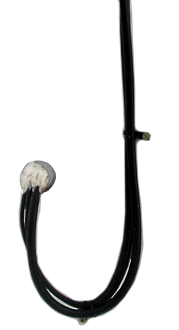Base Station 2.0 Antenna Installation
Site Requirements
The following items are required before the Raven Slingshot® base station 2.0 may be set up:
- A dedicated, broadband internet connection (DSL, cable, etc.) with DHCP support is preferred, but a business network can be used.
- A dry, temperature controlled environment suitable for computer equipment with a connection to a dedicated internet line and adequate power receptacles.
- A location within reach of the base station antenna mounting location and cable (maximum cable length 45 m [150 ft]).
Note: The base station tray is compatible with a 1U 19 in [48 cm] server rack for optional mounting.
Installing the Base Station 2.0 Antenna
Before mounting the Slingshot® base station 2.0 antenna, select a site which meets the following conditions to ensure optimal performance:
- Ensure the antenna location provides a clear, 360° view of the sky.
- Antenna should be mounted as far from reflective objects (i.e. metal buildings, water bodies) as possible and should be higher than surrounding obstructions (i.e. tree lines, power lines, etc.).
- If obstructions or reflective surfaces are within 30 m [100 ft], mount the Slingshot® base station as high as possible to minimize interference and/or multipath
 error induced in GNSS corrections due to signals arriving at the GNSS antenna after reflecting off of or diffusing from objects around the vehicle. reflections. If no obstructions or reflective surfaces are within this range, mount the antenna as low as possible.
error induced in GNSS corrections due to signals arriving at the GNSS antenna after reflecting off of or diffusing from objects around the vehicle. reflections. If no obstructions or reflective surfaces are within this range, mount the antenna as low as possible. - Use a sturdy mounting bracket with a 5/8 in -11 NC thread. The thread must be between 9.6 mm to 22 mm [3/8 in. to 7/8 in.] long to ensure proper mounting and avoid damage to the antenna casing. If the thread length is longer than 22 mm [7/8 in.], use two jam nuts to shorten the exposed thread.
- The antenna mount should provide a solid base for the antenna and should not allow the antenna to move in any direction.
- Mount the antenna with the thread adapter and TNC cable connector facing toward the ground.
- Make sure the entry point into any building or structure is properly sealed to prevent moisture from migrating into the building and causing damage to the Slingshot base station or other property. Use a drip loop to keep moisture away from the entry point.
Note: It is recommended to contact a qualified electrician to route the cable into the building.
- To prevent damaging the antenna cable, do not route cables through potential crimp points such as doors or windows. Avoid severe bends in the cable as this may also cause damage to the cable.
Specification Units Bend Radius (Installation) 25.4 mm [1.0 in.] Bend Radius (Repeated) 101.6 mm [4.0 in.] Bending Moment 0.68 N-m [0.5 ft.-lb.]
Mount the Base Station Antenna
To install the Slingshot base station antenna:
- Verify that the thread on the antenna mount does not extend more than 22 mm [7/8 in.] to ensure the plastic inside the antenna receptacle is not damaged when the mount is inserted. If the thread length is longer than 22 mm [7/8 in.], use two jam nuts to shorten the exposed thread.
- Thread the metal adapter on the bottom of the antenna onto the mount.
Note: The metal adapter is fixed to the antenna body. Do not attempt to remove this piece.
- Use a wrench, tighten the antenna adapter to the mount to secure the base station antenna.
- Remove the dust cap from the TNC connector on the antenna.
- Attach one end of the provided base station antenna cable to the antenna and route to the selected base station location.
Note: If the antenna will be mounted on a tower structure, be sure to leave enough slack in the antenna cable to allow for expansion and contraction of the structure to avoid damaging the cable. Raven recommends contacting a certified electrician to assist with cable installation and routing.
If the antenna cable will be routed into a building, be sure to use a drip loop to prevent moisture from entering the building by wicking along the cable. Also, be sure to seal any building penetrations properly to prevent moisture and condensation.
Care and Maintenance
The base station antenna is designed to withstand the elements, including rain, snow, and dust. To ensure that the antenna continues to perform as desired, keep the radome (top surface of the antenna) clear of snow and ice and clear any debris as necessary.
Ensure that the TNC antenna cable connector remains clean and dry. If the cable will be disconnected from the antenna for any length of time, replace the dust cap on the antenna.
Last Revised: Sep 2024

